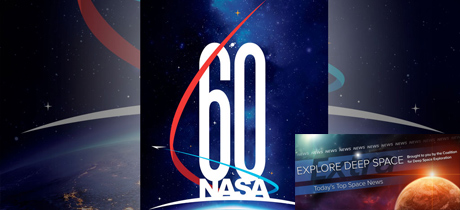In Today’s Deep Space Extra… NASA turned 60 on Monday, as many of the world’s top space agency administrators gathered in Germany for the International Astronautical Conference. China’s Zhang Kejian, who was among the heads of agency, used the forum to reach out in search of potential international partners for exploration of the Moon and operations of an Earth orbiting space station in the 2020s.
Human Space Exploration
Sixty years of NASA, thirty years of NASA leadership
The Space Review (10/1): NASA marked its 60th anniversary on Monday, moving on from its roots as the National Advisory Committee on Aeronautics to tackle human spaceflight, lunar exploration and the assembly of the International Space Station (ISS). The anniversary followed by two week a reflective gathering of five previous administrators at the AIAA Space Forum in Orlando, Florida, and it was clear from their comments that while the astronauts face risk in space, the political environment of space exploration has also proven challenging to navigate.
Five reasons to forget Mars for now and return to the Moon
Space.com (10/1): An acknowledged horizon goal for human exploration, Mars, seems a leap too far in the near term. The lunar environments, however, offer a range of resources to pave the way to Mars as well as a place to study how humans launched great distances from the Earth respond physically and psychologically to the challenges. Then there is the science, learning more about how the planets formed and using the Moon as place for radio observatories.
Space Science
Signs of plant life may be easier to spot on older planets, scientists find
Space.com (10/1): When it comes to looking for hints of life beyond Earth, older planets may be more favorable to plant growth. That could mean that searching for the “vegetation red edge,” or high levels of near infrared radiance, could offer a promising lead in the search for life beyond Earth, according to a recent study led by Cornell University astronomers and published in the journal Astrobiology.
NASA’s aging planet-hunting Kepler telescope is struggling to see straight
Space.com (10/1): NASA is seeing more signs that the Kepler space telescope, a prolific discoverer of extra solar planets launched in 2009, is running low on fuel and that its mission may soon come to an end. Operations have been suspended until October 10 to save fuel for a data relay session. Earlier this year, NASA launched a successor to Kepler, the Transiting Exoplanet Survey Satellite (TESS).
The “death comet” will pass by Earth just after Halloween
Universe Today (10/1): An asteroid with an eerie appearance and an imposing name, the Death Comet, will pass safely past the Earth on November 11. Estimated at 1,300 feet wide and with a skull like appearance, the comet made its first detected pass by Earth in 2015.
Other news
NASA opens door to additional cooperation with China
SpaceNews.com (10/1): During the opening day of the International Astronautical Conference in Bremen, Germany on Monday, leaders of both NASA and the China National Space Exploration Agency expressed interest in expanding cooperation in the exploration of space. China expressed interested in cooperation in the exploration of the Moon and China’s new space station. Currently, NASA is prohibited by Congress and the Wolf Amendment from working bi-laterally with China. NASA Administrator Jim Bridenstine, who met with his Chinese counterpart, Zhang Kejian, noted, “We do cooperate in a lot of ways, but that doesn’t mean our interests are always aligned. To the extent that agencies and countries from around the world can cooperate on space, it is absolutely in our interest to do so. I look forward to exploring more opportunities to do that.” But those opportunities may come in the form of sharing science data and cooperating in the area of space situational awareness, according to the report. Bridenstine did not suggest the Wolf Amendment be lifted soon.
China invites international cooperation in Chang’e-6 Moon sample return mission
GB Times of Finland (10/1): The China National Space Administration plans to make a 10 kilogram payload capacity on China’s Chang’e 6 lunar sample return mission available to an international partner. The offer was announced October 1, opening day of the International Astronautical Congress underway in Bremen, Germany. The mission is planned for the 2020s as part of a Chinese lunar exploration effort focused on the Moon’s north and south poles, which are believed to harbor water ice deposits, a resource for human exploration.
Russian Roscosmos chief looks forward to new projects with NASA
TASS of Russia (10/1): Dmitry Rogozin, head of Russia’s space agency, Roscosmos, offered his congratulations to NASA Monday, which marked the U.S. space agency’s 60th anniversary. Rogozin called for cooperation with NASA in future exploration endeavors.
Roscosmos head claims anti-Russian sentiment affecting cooperation with NASA
Radio Free Europe (10/2): During an interview with Russian news outlets on Monday, Dmitry Rogozin, head of Roscosmos, the Russian space agency, expressed concerns that anti-Russian sentiments in the U.S. could jeopardize relations with NASA and cooperation in International Space Station (ISS) operations. The difficulties are not the fault of NASA, said Rogozin.

